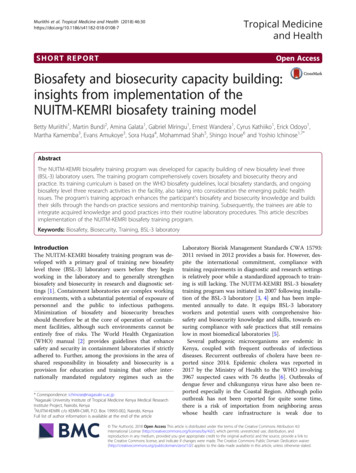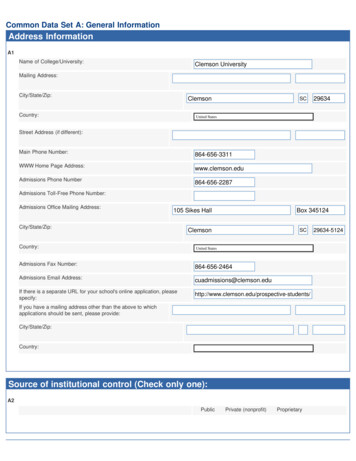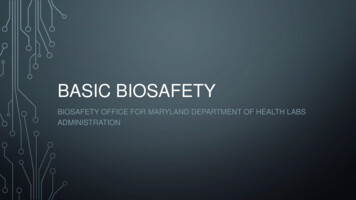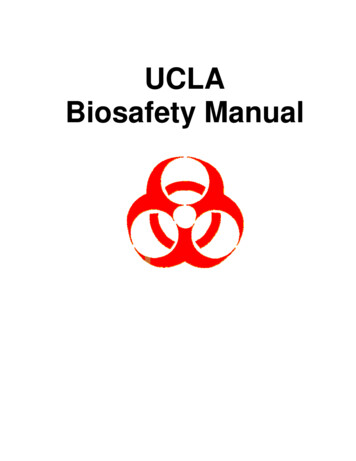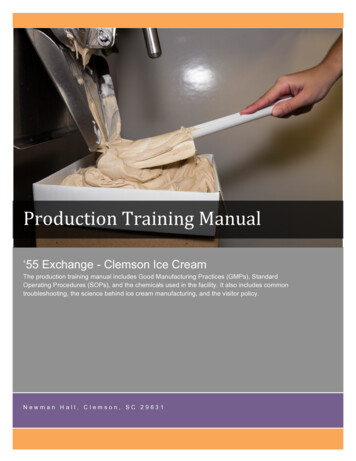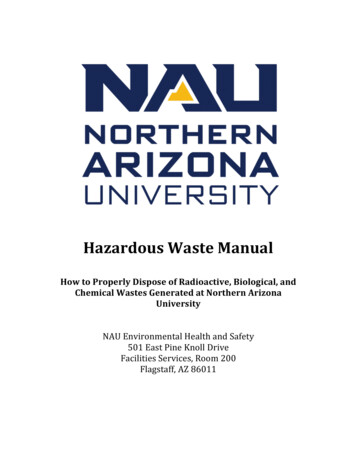
Transcription
Biosafety and Biohazardous WasteTrainingKerri Kwist, Biosafety Officer
Who needs to take this training? You need to take this training if you generate biohazardous waste,whether that waste is infectious or not infectious You need to take this training if you have the potential to generatebiohazardous waste. People who work in research labs, people who deal with humansamples, animal care workers, and people who work with plants.
Biosafety and Biohazardous Waste The hazards of working in a lab with biological materialsare unique and require specialized training. This trainingwill help to identify ways to keep workers safe. There are also regulatory requirements for working withthese hazards and this training will also cover thoserequirements.
What is Biosafety? Maintaining safe conditions to prevent harm to people orthe environment from biological materials. Examples of these biological materials include: humanmaterials (blood borne pathogens), microorganisms,Recombinant DNA (rDNA).
Oversight of Biosafety Several governmental agencies provide guidance overthese hazards. They include OSHA, SC DHEC, CDC,NIH. Clemson has its own level of oversight through theInstitutional Biosafety Committee, the Institutional AnimalCare and Use Committee, and the Office of ResearchSafety.
Types of Biohazards at Clemson Pathogenic microorganisms – bacteria, viruses, fungi, parasites,etc that cause disease Human materials – patient samples, cell culture Recombinant DNA (rDNA) – artificially made DNA from2 sources Animal work – zoonotic disease (pathogen transferred from ananimal) Wastewater samples – sludge and biosolids.
Where do we find these biohazards? Labs in multiple buildings and departmentsGreenhousesFarmsOff campusMost facilities!
Risk Assessment What is a risk assessment?– Identify what the hazards are.– Determine possible outcomes.– Find a solution.
Risk Groups for Microorganisms Microorganisms are microscopic bacteria, viruses etc.Some of these are pathogenic, which can cause disease. The CDC has assigned “Risk Groups” to microorganismsto aid in risk assessment. The lowest risk microorganisms are classified as RiskGroup 1. These do not normally cause disease in healthyadults. Risk group 4 has the highest level of risk. At Clemson, we have RG-1 and RG-2 agents.
Risk GroupsTo aid in the risk assessment of biological hazards, the CDC has created 4 categories for microorganisms.Risk Group 1 is the least hazardous and Risk Group 4 is the most hazardous.
Biosafety Level Using the risk group, it can then be determined what levelof containment to use. This is also referred to as theBiosafety Level (BSL). Containment refers to the safety mechanisms in place. The Biosafety Level usually, but not always, correspondsto the Risk Group. At Clemson, we have BSL-1 and BSL-2 labs.
Biosafety LevelDepending on the hazards, you would use an appropriate biosafety level, or containment, tomitigate that risk.
Risk Groups usually corresponds to the Biosafety Level
Ways to Control Risk
Ways to Control Risk1. The most effective way to control risk is to ELIMINATEthe hazard. No hazard means no risk!2. If you can’t eliminate the hazard, can you SUBSTITUTEit for something less dangerous? (i.e. non-pathogenicstrains)3. Use ENGINEERING CONTROLS to separate the hazardfrom people and/or the environment. Includes lockingdoors, air flow, Biosafety Cabinets, etc. (cont. next slide)
3a. Engineering Controls - Biosafety Cabinet A biosafety cabinet usesairflow to direct hazards awayfrom the lab worker. The cabinet also protects thesamples from possible outsidecontamination. This cabinet is required forwork done at a BSL2 level. Not appropriate for chemicaluse.
Ways to Control Risk (continued)4. ADMINISTRATION CONTROLS change the way peoplework. This includes trainings and posting signs that wouldalert people to the hazards and give ways to manage therisk.5. PERSONAL PROTECTIVE EQUIPMENT or PPE. It isthe first (or last) line of defense from hazardous materials.
PPE Starts with LONG pants andCLOSED TOED shoes. In all labs with chemical orbiological hazards, lab coatsand safety glasses arerequired. Fit is essential. Nitrile gloves should be usedas needed. Other examples would be UVface shield, cryogenic gloves,autoclave gloves, etc.
Other Biosafety ConcernsSharps Broken glass, syringes, scalpels Special care must be taken withthese items. Sharps are usually consideredinfectious. Sharps containers are provided byResearch Safety.Aerosols Droplet generating activities ofbiohazardous materials. These types of activities must bedone in a BSC or an enclosedspace.
Biohazardous Spill Cleanup Follow the Biosafety Manual rules for spills– Cover with absorbent material (paper towels, etc.).– Soak the absorbent material with 0.5% sodium hypochlorite (1:9 dilution ofhousehold bleach – 10% bleach) for at least 10 minutes unless somethingelse is more appropriate.– Use appropriate PPE.– Place spill materials in a plastic bag then package for Hazardous Wastepick up (i.e. Label “Hazardous Waste. Sodium Hyopochlorite spill cleanup. Oxidizer”).– Report the spill to your supervisor. If it is a large spill ( 500 mL) contactthe BSO.
What do I do if I amexposed? In an emergency, go to the nearest emergency medicalfacility. Call “compendium” CorVel.* Go to Redfern. Report the exposure to your supervisor as soon aspossible. Your supervisor will then follow the methods prescribed inthe Exposure Control Plan (i.e. contact ResearchSafety).**
Biohazardous Waste Disposal of biohazardous materials needs to be doneproperly to ensure the safety of the community and theenvironment. Regulated by SC DHEC. Red bins and bags are providedby Research Safety.
Types of biohazardous waste1. Lab trash – lab waste that can go in the trash (i.e.gloves, packaging, empty bottles). Non-hazardous.2. Biohazardous waste - This is waste that is hazardous,but not infectious. It does need to be treated beforedisposal (i.e. RG1 bacteria, animal waste, petri dishes,rDNA waste) so it does not get into the environment.3. Infectious waste – This waste could be infectious.Includes human materials waste, BBP, RG2 organisms,sharps.
Non-hazardous waste (Lab trash) Can go in regular trash. Includes certain plants and items that may have touchedbiologicals (not rDNA) Trash that does not look like medical waste. Use your best judgment. If something looks like it might behazardous, just dispose of it as biohazardous waste.
Biohazardous Waste This is waste from a non-infectious source but needs tobe treated before disposal to protect the environment. Don’t put this type of waste in the regular trash! Includes bacteria that are non-infectious (RG1), animalwaste, materials from recombinant DNA work, items thatappear to be medical waste.
Infectious Waste This waste could be infectious and pose a risk to humanhealth or the environment. It needs to be treated before disposal. Includes infectious microoganisms (RG2), humanmaterials that may contain blood borne pathogens, andsharps.
How to dispose Biohazardous and infectious waste can be:– Treated in the lab: chemical and steam sterilization OR– Collected and picked up by Research Safety Both types are treated the same; however, infectiouswaste MUST be logged.
Treating liquid waste – chemical disinfection1. Add bleach to 10% volume of collected liquid waste (ifyou have 90ml of liquid, add 10ml undiluted bleach)2. Let sit for 10-20 minutes.3. Pour down drain and flush withcopious amounts of water.4. LOG infectious waste.
Steam sterilization for solids and liquids Use certified autoclave that is tested with a bioindicatoronce a month. Autoclave bags should be CLEAR and NOT have thebiohazard symbol on them. Load autoclave and run for 30-40 minutes at 121degrees C and 15 PSI Use lead free autoclave tape LOG infectious waste.
Logging infectious waste Clemson’s waste permit isbased on how muchinfectious waste is produced. Every time infectious waste istreated and disposed of in thelab, it should be logged. If you aren’t sure if it isinfectious our not, just log it! Logs should be sent to BSOon a regular basis.
Packaging biohazardous waste for pick up Line a biohazard bin with 1 bag(use 2 bags for animal carcasses). Fill bin not to exceed approximately 40 pounds. Tie or tape inner bag. Place biohazard waste label or non-infectious label oninner bag. Close lid on bin. Place “biohazard waste: label or “non-infectious biohazardwaste” label on outside of bin. You do NOT have to log infectious waste if it is getting pickedup by Research Safety.
Request a biohazardous waste pick up
Mixed Waste Biological/Chemical/Radioactive Chemical waste and Radioactive waste take priority overBiohazardous waste. Do NOT treat without guidance from Research Safety. Please contact Research Safety for more info.
Review Biology labs contain unique hazards and requireoversight. Understand the risk involved and the containment level. Know what equipment there is for protection and knowwhat to do in an emergency. There are different types of biohazardous waste anddifferent ways to dispose of this waste.
Kerri Kwist – Biosafety Officerkkwist@clemson.eduJune Brock-Carroll – Hazardous Materials Managerjuneb@clemson.edu
Proceed to the ining/biotraining/biowasteQuiz.htmlYOU MUST TAKE THE QUIZ AND FILL OUT THE FORMAT THE END IN ORDER TO GET CREDIT FOR THISTRAINING.
Non-hazardous. 2. Biohazardous waste - This is waste that is hazardous, but not infectious. It does need to be treated before disposal (i.e. RG1 bacteria, animal waste, petri dishes, rDNA waste) so it does not get into the environment. 3. Infectious waste - This waste could be infectious. Includes human materials waste, BBP, RG2 organisms .

